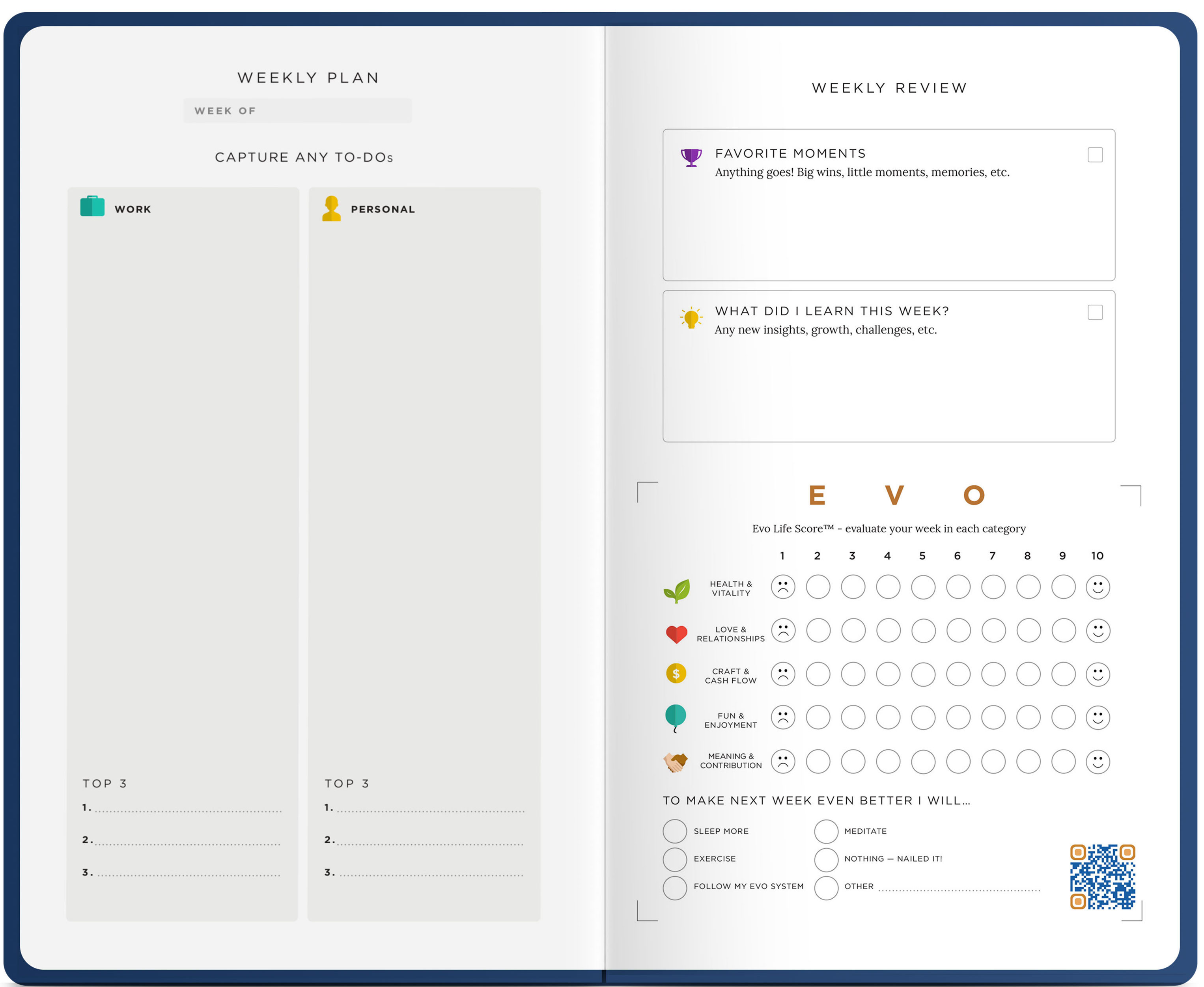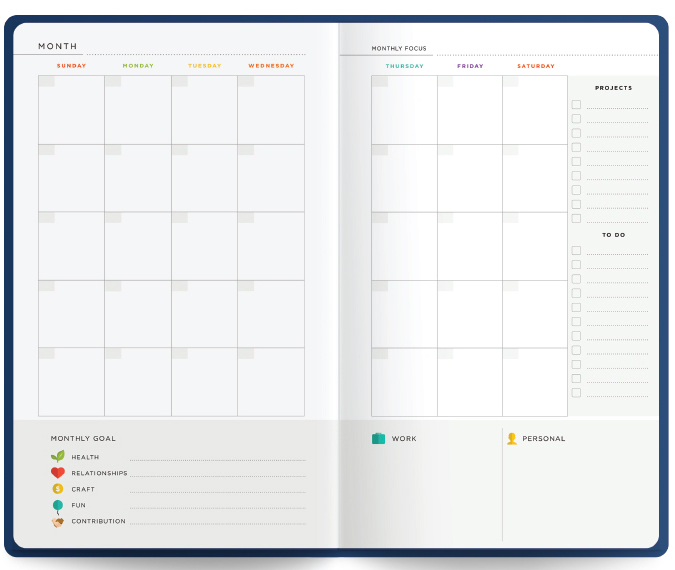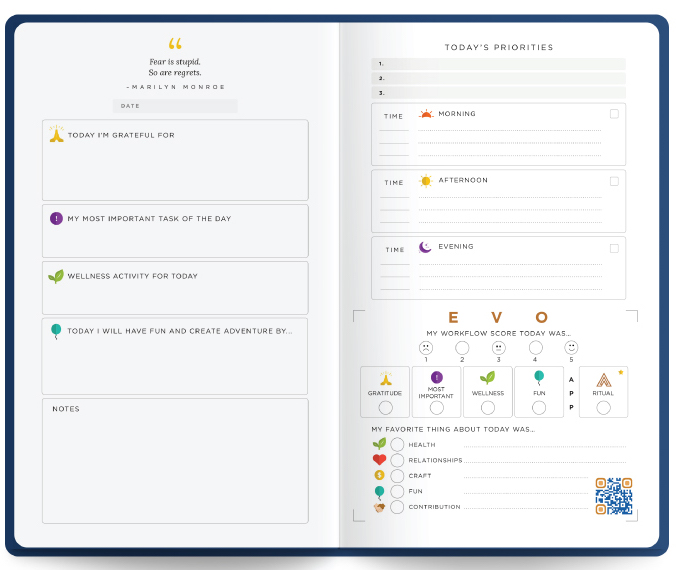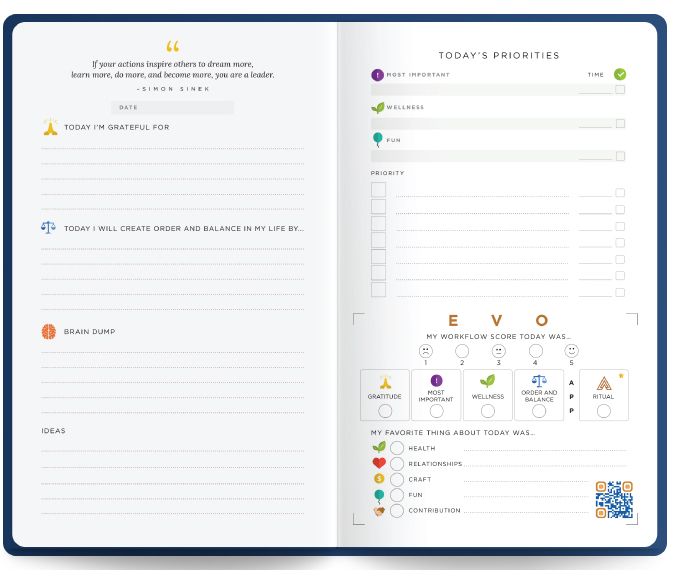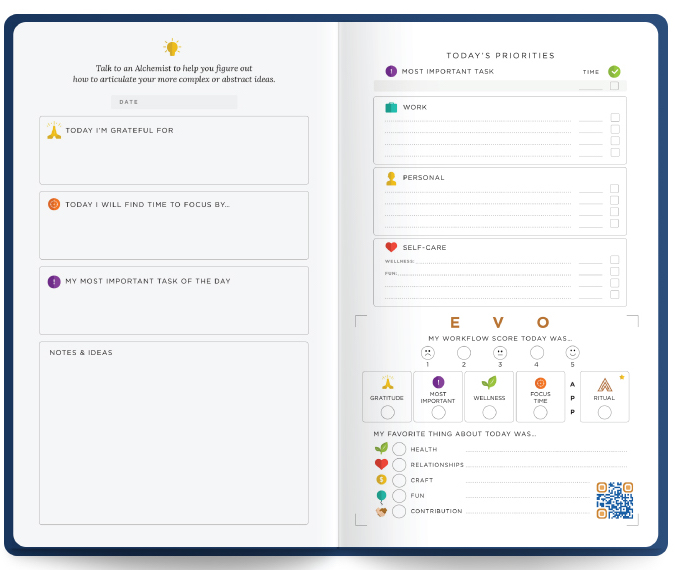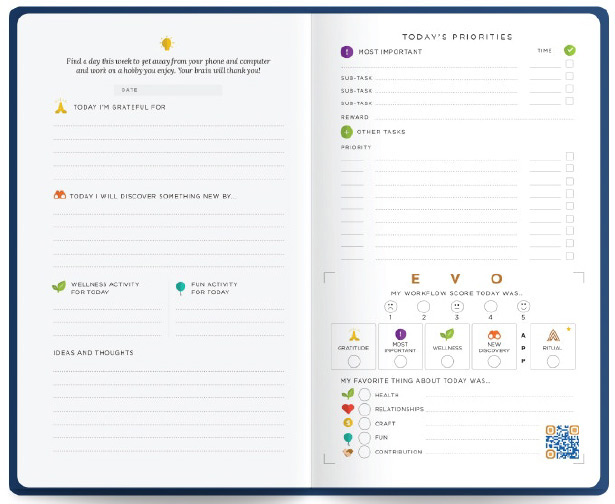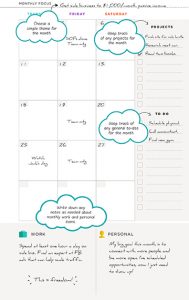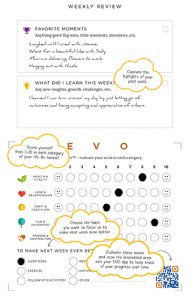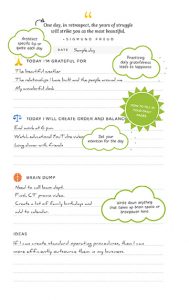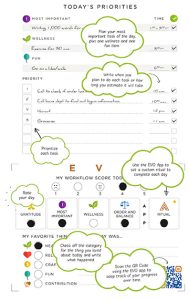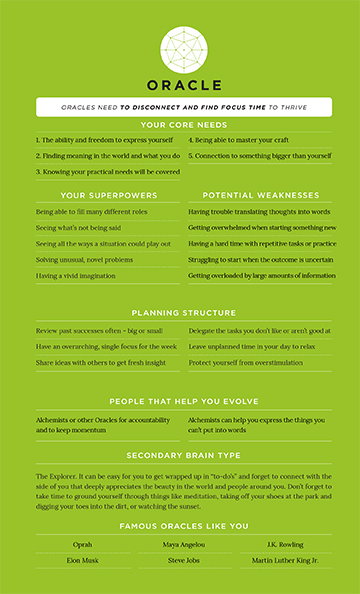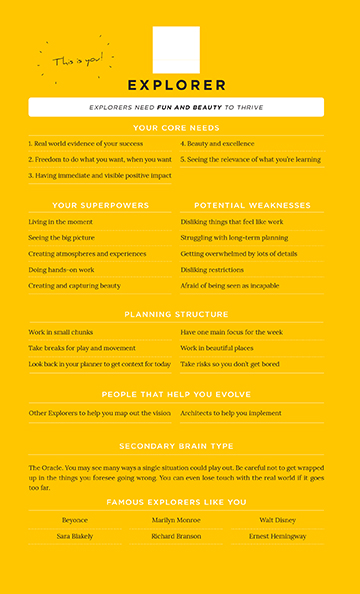BLOG
a
History and insights into the EVO Elements Assessment
by Iris Strauss
1883 views

I’d like to share the story of how we developed the ideas for the EVO Elements: the Brain Types and Compasses, the Elements Assessment, and the path that led us to develop the world’s first and only planner customized to work with the way your brain naturally operates.
Starting with a wildly successful crowdfunding campaign which raised over $1M, we debuted our beautiful planners based on the concept of Brain Type back in 2018. Brain Types (and EVO Elements in general) are ways of describing mental processes that individuals use and experience in varying degrees all the time. These ideas bring the world a new system of language to help describe who you are, what you do best, and how to grow into the most optimal version of yourself.
Distilling these complex ideas down to their essential nature, we created a short, organizationally-based Brain Type Assessment to help match people with the style of EVO Planner designed to work with the way their brain naturally operates. Since 2018, the Brain Type Assessment itself has grown exponentially in popularity—with over 400,000 assessment-takers to date worldwide.
But the true vision for what these ideas could offer finally began to be realized in October 2019, when our team put the concept of “evolution” to task—we released Project EVO’s true flagship creation: The EVO Elements Assessment, in late 2019. The EVO Elements system proposes that there are four main methods of making decisions, called Compasses, as well as four methods of processing information, Brain Types—these eight processes are the “Elements” in “EVO Elements”—and everyone uses two main Compasses, and two main Brain Types. The different ways these Elements play together can be used to help describe how various individuals operate.
The original inspiration for the concept of this system were the theories presented by Swiss psychiatrist Carl Jung in his book, Psychological Types, released in 1921. EVO Elements Assessment creator Beckett Hanan began studying the works of Jung in the early 2000’s, later teaming up with several other like-minded individuals, including myself—Iris Strauss (and since then, I’ve gone on to become Project EVO’s Director of Community and our resident Elements Expert). Our group conducted interviews with people from all walks of life, all over the world, to determine how Jung’s theories held up in a practical sense. Throughout these interviews and 1-on-1 sessions, we made extensive notes and looked for patterns in the language people use to describe their specific processes and mental landscapes.
Hanan then brought this research to Project EVO co-founders Chad Mureta and Arman Assadi in the mid 2010’s. By this time, all of us on the EVO team knew that our research had evolved our ideas far beyond, and in much more depth, than what Jung originally presented, and so we set about creating our own language to describe this new system. While other theories and assessments have also borrowed from Jung’s ideas, the direction that our team has taken this research has led to a system that in my opinion, stands alone as distinct from any others (and I’ve done a lot of research on various personality assessments and systems throughout the years).
After developing this system and testing many iterations of the precursor to the Elements Assessment for over a decade, we finally launched the EVO Elements Assessment in 2019, and I believe it truly is an assessment for the 21st century, maximizing content while also managing to minimize effort on the part of the assessment-taker. Estimated completion time for the EVO Elements Assessment is 14 minutes maximum—much lower, compared to the standard 45 minutes for many other personality assessments. Despite the relatively short assessment, those who have taken it often report that the 39-page report they received was the most well thought out, in-depth, and accurate portrait they’ve ever received from a personality assessment.
The EVO Elements System
The EVO Elements are thought of as processes which are natural, inherent mental preferences that are either inborn or developed from a very early age—similar to the way people experience a preference for using either their right or left hand to do most complex tasks. Using your preferred Elements is automatic and easy, which also means they are also commonly taken for granted, rather than being seen as your own special skill.
The eight EVO Elements are:
Brain Types:
- Alchemist—processing external information in an expansive, abstract way (pairs with Architect).
- Architect—internally processing information in a concrete, linear way (pairs with Alchemist).
- Oracle—internally processing information in an abstract, nebulous, and non-linear way (pairs with Explorer).
- Explorer—processing external information in an expansive, concrete way (pairs with Oracle).
Compasses:
- Determined —making quick, in-the-moment decisions based on what is objectively logical and the most effective solution (pairs with Compelled).
- Compelled—making long-term, contemplative decisions based on one’s own internal moral and ethical gut instincts (pairs with Determined).
- Relational—making quick, in-the-moment decisions based on one’s gut instincts and what best serves the collective (pairs with Strategic).
- Strategic—making long-term, contemplative decisions based on one’s own internal logical framework and the most accurate/precise solution (pairs with Relational).
The Elements are presented as pairs because together, each pair portrays the expansive and complex nature of human mental abilities. Each set of Brain Types represent ways of processing both abstract and concrete information, as well as representing information processed internally in the mind, and a process used externally to interact with the world and other people. And likewise, each set of Compasses represent ways of making decisions that are both logical and based on gut instinct, while also accounting for the fact that some decisions must be made quickly, in the moment, and other decisions allow for longer-term contemplation.
By understanding which set of Elements someone uses for different types of processing, a new path to understanding that individual opens up. Unlike a trait-based system like Myers-Briggs, which uses dichotomies to label people as one thing or another—for example, designating those who take the MBTI as either introvert or extravert*—an individual’s mind is made up of every kind of process within the Elements system. This comes from the primary idea behind the Elements: that everyone is a little bit of everything, and that human mental functions should simply be described, rather than trying to force them to fit into a dichotomy—or any other rigid, forced choice, for that matter.
Some other personality systems focus more on people’s strengths, or the negative aspects of who you are. Enneagram, for example, is a system that categorizes people based on their core fears. Or, conversely, CliftonStrengths (formerly StrengthsFinder), which is all about highlighting things people do exceptionally well. EVO Elements, however, presents a more balanced portrait of the individual, because Elements are simply mental processes. These processes are neither inherently good nor bad—they’re more like tools.
To illustrate this idea, think of a hammer. A hammer can be used to build or destroy things depending on how the operator chooses to wield it. There are jobs it does exceedingly well, like drive nails into wood, and other jobs it just isn’t cut out to do, like slice bread. Elements are similar—individuals are responsible for the consequences of their actions, regardless of how they naturally see or do things. Certain people are very well suited to certain things while not being so naturally adept at other things—for example, Core Strategic people tend to be good at math, but aren’t typically born networkers. But that doesn’t mean people with other Elements or different Element priorities can’t learn math and excel in it, just as Core Strategic people can still learn to become skilled networkers. This balanced approach not only helps individuals see a clearer picture of themselves, but I also believe that it more accurately portrays the reality of complex human nature.
So each set of Compasses and each set of Brain Types fulfill each other and describe the relationship people have with all the different processes identified herein—although the extent to which a given person uses certain Elements or the complexity with which they experience other Elements will differ depending on their own personal mental makeup. Each Element, whether that Element is a Compass or a Brain Type, is a layered and multi-faceted process that possesses a particular relationship to the other Elements a person uses. These components and the relationships between them are what make up a person’s EVO Elements, which are revealed in their 39 page EVO Elements report upon completion of the assessment.
In our system people are referred to by their top Compass and top Brain Type, with an asterisk denoting which of these two elements is actually the individual’s first priority, so EVO Elements results look like this: “You are a Relational* Oracle.” The asterisk(*) denotes that first priority Element, which is called the “Core” element and is most important to understanding how they operate, while also typically being the most automatic process an individual uses.
The order which your Elements are presented in are very key to understanding yourself in this context. Each of your Elements does not exist in a vacuum—the order of your Elements present a way to describe the most optimal, best, and most balanced version of yourself.
The relationship between your Compasses and Brain Types and how they interact with each other are meant to describe who you are at your very core, how your mind works, your strengths, and your weaknesses. Compasses and Brain Types are considered expansive mental processes deeply rooted in your psyche and their relationship to each other can help provide an understanding of the trajectory of your own personal growth throughout your life.
Most other personality systems use traits and behavior to try to define how people’s minds work and who they are, because that’s generally easier than trying to describe someone’s mental process. But seeking to understand your Elements is a direct approach to getting insight into how your mind works, why it works that way, and your true core nature. This can give you a deeper understanding of how you prefer to process information and make decisions, and how these preferences manifest in various strengths, as well as how they may create blind spots or challenges.
This not only makes the results more insightful, but many users have also reported that they feel their EVO Elements Assessment results are more accurate than results they’ve received after taking other personality assessments.
The final component of this system is to identify your top Crafts—which describe the various roles you play in life. Since your Crafts are separate from your EVO Elements, they are not as deeply rooted in your psyche as your Compasses and Brain Types. The understanding of these roles comes from a more behavioral perspective than the EVO Elements. People may take on different roles throughout their life for a myriad of reasons, and they might remain in these roles to grow or survive, or they might take on new roles when wanted or needed, and this is what Crafts represent. EVO Crafts have names such as Innovator, Rebel, and Star, and along with your Elements, your results include your top three Crafts, including suggestions for getting better aligned with these roles.
If you’ve ever taken an assessment of this nature and thought, “Well, what now? What am I supposed to do with this information?”—you may find that the EVO Elements Assessment is one of the only assessments to provide a satisfactory answer. When you get your EVO Elements Assessment results, you are given a detailed roadmap with a myriad of suggestions for how to use the information to improve your strengths and strategies to cover your weaker areas.
A common benefit to taking any personality assessment is gaining a frame of reference for understanding that some people are fundamentally different from you. Simply knowing that others operate differently to how you operate can be a very eye-opening experience, especially the first time you realize this truth. Psychologists call this phenomenon “theory of mind.” Developing a better theory of mind helps facilitate empathy and compassion for others, especially those vastly different from ourselves.
But EVO Elements takes this one step further by also giving you a detailed look into how you operate compared to how others do. By giving you language for discussing differences in thought processes, mental landscapes, and perspective lenses with your partner, your family, friends, co-workers, boss, or teacher, you can reach new levels of understanding and greater intimacy than you may have thought possible. Having this language can help improve your relationships, hone your interpersonal skills, realize your purpose, and discover that some of the things you’ve always taken for granted are actually powerful abilities that you can harness to improve yourself and the world.
Do you want to take the next step in your own journey of personal evolution and ascend to the next level of your true self? Take the EVO Elements Assessment now!
Appendix:
Possible EVO Elements Results:
Relational Architect
Relational Oracle
Compelled Alchemist
Compelled Explorer
Determined Architect
Determined Oracle
Strategic Alchemist
Strategic Explorer
EVO Crafts:
Storyteller
Rebel
Chief
Cultivator
Influencer
Weaver
Creator
Sage
Professor
Mentor
Visionary
Builder
Investigator
Persuader
Star
Advocate
Inventor
Composer
Maximizer
MBTI Types:
ENTJ
INTJ
ENFJ
INFJ
ESTJ
ISTJ
ESFJ
ISFJ
ENFP
INFP
ESFP
ISFP
ENTP
INTP
ESTP
ISTP
Enneagram Types:
1, The Reformer
2, The Helper
3, The Achiever
4, The Individualist
5, The Investigator
6, The Loyalist
7, The Enthusiast
8, The Challenger
9, The Peacemaker
CliftonStrengthsFinder Strengths:
Analytical
Context
Futuristic
Ideation
Input
Intellection
Learner
Strategic
Activator
Command
Maximizer
Self-Assurance
Significance
Communication
Competition
Woo
Adaptability
Connectedness
Developer
Empathy
Harmony
Includer
Individualization
Relator
Achiever
Arranger
Positivity
Belief
Consistency
Deliberative
Discipline
Focus
Responsibility
Restorative
